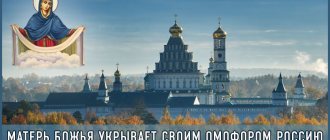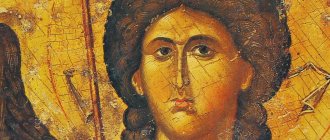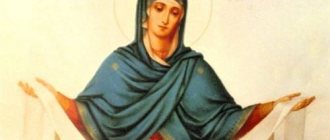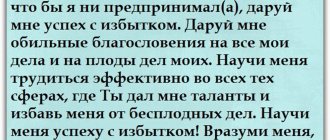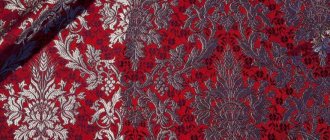Omophorion is a Greek word meaning “carried on the shoulders.” Other names: amice (ramen - shoulders), maforium. In ancient times, an omophorion was a large scarf that fell over the shoulders, and it was part of women's clothing. Now the omophorion is part of the liturgical vestments of the bishop.
There are two types of omophorion:
- great omophorion - a ribbon about one and a half meters long (depending on size), quite wide. They are put on, going around the neck, one end is brought behind the back, the other lies on the chest, the ends reach almost to the hem of the sakkos;
- small omophorion - both ends of the ribbon are fastened on the chest.
The omophorion is sewn from the same fabric as the sakkos and decorated with images of crosses.
The decoration of the omophorion is similar to the decoration of the deacon's orarion: stripes of another fabric are sewn along the long sides, and two parallel strips across at both ends.
Spiritual meaning
The meaning of the omophorion is explained by Saint Simeon, Archbishop of Thessalonica: “Omophorion means the incarnation of man for our sake and the incarnation of the Word that was from the Virgin.” The omophorion symbolizes the lost sheep, which the Lord took on his shoulders - that is, our human nature, came down from heaven, became incarnate and, called the lamb, was sacrificed for our sins.
The omophorion reminds us that the bishop is the image of Jesus Christ, and has the same care for the flock entrusted to him as the Lord. The bishop must be like the Lord in everything - also be ready to lay down his life for his friends, that is, for the Church of Christ, be zealous for preaching the Gospel, fight heresies and schisms, admonish and correct sinners.
Whom the Mother of God covers with her omophorion.
“The Most Holy Theotokos saves evil and unclean people, but if they, like the animals in the ark, change their rage into meekness; For in the ark the lion did not torment the deer, nor the hawk the dove, nor the wolf the sheep, nor the bear the cow, but they all stood meekly; so sinful people must change their character under the cover of the omophorion of our Lady in order to be saved from eternal destruction; otherwise they will be expelled and perish” (St. Demetrius of Rostov. “Word on the Protection of the Most Holy Theotokos”).
The Mother of God does not rejoice when they sing “Rejoice” to her, and at the same time they wallow in their passions.
O. Seraphim: Is every person who resorts to the Mother of God covered with her honest omophorion?
It is said: “Strive towards Her along the path of repentance,” and only those who intend to change their sinful, passionate disposition to a godly one that will save the soul can hope to be under Her protection. But what if a person is not going to leave his bestial disposition, does not intend to change himself, does not strive to eradicate sinful skills, habits, passions, the spirit of selfishness and pride? There is no cover over that person! At least he sang sweet chants, akathists and canons. In one of the teachings of St. Maxim the Greek , on behalf of the Most Holy Theotokos he addresses the ritualist: “Why do you sing me stichera and sweet-voiced troparia, why do you sing to me many canons and exclaim “Rejoice, Rejoice!” Why should I rejoice if you trample on the commandments of my son? I am not at all happy about this, and for me you are no better than a pagan, although “you bear the name that you are alive, but you are dead.”
So in the 20s of the last century, in Bulgaria, one boy died and then suddenly resurrected. And he began to tell how he was caught up into heaven, to the throne of God. And there he saw the Mother of God crying and sobbing before Him. She turned her most pure face to him, which was all sad and filled with tears, and told the boy that he would not stay here, but would go back, but asked to tell everyone how people tormented Her with their sins, how She was exhausted.
And at the same time on earth they sing: “Rejoice!” Does the Mother of God rejoice when Her son’s commandments are trampled upon? When everyone is mired in passions and vices? When is the right struggle with passions forgotten and abandoned? - No. The Mother of God does not hear them, She does not rejoice at all these holidays.
Whom does the Most Holy Theotokos cover with her veil and who does not?
In churches they sing that the Mother of God extends her omophorion over them. But if the singers remain in their passions and lusts, are possessed by a self-proud spirit, sit on the feeling of their correctness and righteousness, on the spirit of self-affirmation, then although they sing about the Protection of the Mother of God, it is not there! - The Most Holy Virgin does not cover such people with her Veil! For He is the radiance of Divine Grace, and how can He cover those who themselves reject It with their sins and passions?
Those who want to imitate the virtues of the Mother of God are worthy of the Protection - “God looked upon the humility of His Servant” (Luke 1:48) - who force themselves to a true, genuine feeling of humility, meekness and kindness, to a feeling of mercy and compassionate love, good nature and spiritual simplicity, love for truth and truth - this is what the Most Holy Lady Theotokos spreads her cover over.
The Mother of God moved away from all sin and wickedness, so we must also move away from all sinful communities and not participate in their sins. — “Blessed is the man who does not follow the counsel of the wicked, and does not stand in the way of sinners, and does not sit on the seat with the destroyer” (Ps. 1). The Mother of God was free from passions, so we must free ourselves from them, eradicating them from ourselves through the correct struggle with our passions. Eradicate anger and irritability, malice and hatred. conceit and the spirit of self-confidence, resentment and hostility, the spirit of pride and vanity, love of money and fornication, and other passions. And if someone follows the lead of his passions and does not wage the correct struggle against them, then the Mother of God cannot cover him with her blessed Veil - or rather, he himself does not want to enter under It, due to attachment to his passions and lack of struggle with them.
People sing beautiful stichera, akathists to the Mother of God, but they approach only with their tongue and lips, and their heart is far away from Her.
The Most Holy Theotokos generously spread Her Protection over Russia, as evidenced by the many intercessions that She showed, by the appearance of many icons. And the reason is that the Russian people for the most part were pious, tried to live according to the Christian faith, move away from everything sinful, and the spirit in society then reigned repentant, contrite and humble. Archdeacon Pavel of Aleppo, who lived in the 17th century, after traveling to Russia, described that the Russians disdained nothing so much as pride, that everyone, young and old, hated it. And in the world, he describes, the spirit of true Christianity was everywhere, and therefore Russia was called the home of the Most Holy Theotokos. But when they began to retreat from the spirit of the commandments of Christ, when they began to plunge into the spirit of wickedness and passions, and when it began to conquer everything, then little by little it began to displace the Spirit of Christ from Christian souls. And in the end, only external righteousness remained, only names, and the spirit of Christ was replaced by ritualism, a Pharisee-legalistic spirit - only the appearance of piety remained, but inside was the spirit of passions, the spirit of the Antichrists.
Satanic Power and the Apostate Church
Evil multiplied, apostasy grew; and Russia was abandoned by the Lord, betrayed to her enemies, adversaries, betrayed to the world forces of evil, who organized a new state - an atheistic, satanic, Soviet-Chekist state, which appeared in the world as if the beginning of the spread of world evil.
And this satanic power found in the church environment those children who agreed to serve it, that is, the enemies of Christ, in the person of the highest hierarchs, in the person of Metropolitan Sergius of Stargorod and the entire Moscow Patriarchate. The satanic Chekist government, with the help of those church Judases who sold themselves for lentil stew, organized the false church of the Moscow Patriarchate, leaving the same rituals and words, the same canons and akathists, where “Rejoice!” is sung, but the spirit of Christ was no longer there, the concepts behind these words were no longer Christian; the spirit of Antichrist had settled there. Could the Mother of God henceforth cover this satanic KGB power with her veil? that church that went to serve this government, the enemies of Christ? Can the Mother of God contribute to their unclean deeds? Could She really assist the communists and Satanists, the servants of the Antichrist, in their conquest of Russia and the whole world? - No, no and NO. This will already be blasphemy against the Most Pure Mother of God, this attempt to unite the incompatible, darkness with light, Christ with the devil. Somewhere, the Mother of God could show her mercy, in some particular cases, and if God’s Providence protected someone, it was only because the Lord, by His mercy, leads everyone to repentance. The Lord expects people to come to their senses, repent, and change. That Providence that protects everyone, be it a pagan or a Jew, and leads everyone to repentance, seeks the salvation of the soul of every person. But this does not mean that the deeds of all these wicked people are pleasing to him - this is long-suffering, the mercy of God. And the Mother of God sheds tears before the throne of God, bursts into tears, seeing the apostasy in the souls and hearts of men, seeing that people do not hunger and thirst for the righteousness of God and the truth, but live according to their own whims and lusts, having loved the satanic lies that this satanic one pours out Chekist power, people loved their passions, the spirit of this world - they loved the spirit of selfishness and pride, they loved bodily and mental voluptuousness - they loved the darkness of passions rather than the light of true virtues (John 3:19). That’s why they became infected with all sorts of heresies, false teachings—they became infected with the spirit of Antichrist.
Icons cry about the death of people, but people remain unrepentant
It is not for nothing that such a number of icons of the Most Holy Theotokos have appeared in our time - crying when the myrrh flows from Her eyes. And this clearly shows us that the Mother of God is crying before the throne of God, seeing that people are going to destruction, seeing the apostasy of all these hierarchs, the priesthood and the people blindly following them.
From the crucifixion of Christ, from the wounds of Christ, blood flows... Are these not clear signs that we are crucifying Christ with our sins! that we are crucifying Him a second time!? And how else can the Lord show admonition to people before the end of the world? So He reveals it through everything possible - so that people come to their senses, repent, and begin to seek the truth. But no one does this, no one hears it!..
And signs from icons are perceived as evidence that we are correct, we are in the truth. They interpret in their favor, without retreating from wickedness and evil. And sometimes they make money from this, that is, they continue to satisfy their passions from this. What truth can we be talking about here!? what kind of salvation? How can the Mother of God cover such people with her honest omophorion!? Moreover, the more the Lord shows his mercy and patience, the more people ossify in their sinful state, harden in unrepentance. They thirst for signs, wonders, healings of diseases and insight; but when the question arises about the truth, about upholding truth and justice, when the question arises about eradicating sins and passions in oneself, then they declare: “Oh, this is not for us, it was the saints who lived like this, but we cannot”…. That is, they no longer want it that way. It turns out that they are no longer looking for something at all, but for something that would satisfy their curiosity, feed the idle inquisitiveness of the mind, the spirit of vanity; they are looking for something from which they can get an effect, an impression, spiritual and voluptuous sensations. “ This is spiritual defilement that spreads through their souls, and they think that they stand in the truth, they think that they are under the protection of the Mother of God. How can She cover up this filth of lies and spiritual voluptuousness!?
The darkness that has enveloped people has closed their eyes, and they do not know where they are going. “We didn’t know,” they will say in their defense on the Day of Judgment. “But you weren’t trying to find out. You did not hunger, therefore I did not give it to you. You did not knock on Me constantly. You did not ask Me to reveal the truth to you. You did not thirst for it,” the Lord will say on the Day of Judgment. The truth was told to you, but you did not listen. People with a petrified heart, no matter how much you convert them, no matter how much you call on them, they will find thousands of excuses for themselves, fueling the spirit of self-justification and self-affirmation in themselves, just to keep up with their sinful and passionate state.
One must hunger and thirst for truth and truth, constantly crying and asking. And then the conscience will begin to bother you: “Something is wrong! Where am I going? Where is truth and truth? That’s when a person begins to fall to God and cry out: “Lord, show me the truth, reveal the truth to me? Enlighten the darkness of my mind? From here will come determination, thirst and hunger for God’s righteousness and truth. And a person will no longer seek the satisfaction of his passion, not the satisfaction of his pride, lust, but the satisfaction of his conscience in order to come into peace and harmony with it. Let this be bitter for my passions, let me have to reject them and tear them out of myself, going through grief, but just to satisfy my conscience, just to unite it with the truth.
And self-pity and reluctance to break with one’s passions seeks out hundreds of self-justifications: “You won’t succeed, but what do you need...Fast, pray, and that’s it, go to church, and you don’t need anything else”...
The feeling of self-satisfaction, the feeling of one’s correctness and righteousness in a person is satisfied, and he is calm, in false peace. But this is precisely death for the soul, this is exactly what Christ spoke about: “Woe to you who are filled today, for you will hunger”... Woe to those who are filled with a sense of self-satisfaction, a sense of their correctness and righteousness, and are satisfied with it.
Only to those who constantly seek the truth, hunger and thirst for the truth of God, God reveals it . It happens that it opens to those who are not looking for it, but they pass by, as if it does not touch their hearts. The word that sounds falls either on the rocky soil of their heart, or falls along the road. Demons come and steal everything with their thoughts, which they induce on a person, sinful, passionate and the worries of this age, the affairs of everyday life. And the person remains in such an empty state, but the demons immediately give him self-justification, and he justifies his such position and condition. And so the words come true over him: Because you are “neither cold nor hot,” for this “I will spit you out of My mouth” (Rev. 3:15,16).
And the Lord will lead those who are thirsty to the path of righteousness and truth, and will not abandon them!
On the meaning of the holidays of the Mother of God
Sermon by Father Seraphim Medvedev, 2007
During service
The bishop performs most of the liturgy in the small omophorion, the rest of the services in the great omophorion.
The omophorion is carried by the deacon in front of the solemn formation of clergy during the reading of the Gospel and at the Great Entrance.
The omophorion and miter are signs of the bishop's high priesthood, a symbol that the bishop presides over the liturgy, just as Jesus Christ presided over the Last Supper. During the reading of the Gospel, the Lord himself speaks to us, so the bishop takes off his omophorion.
Cover us from all evil with Your honest omophorion!
“Rejoice, our Joy! Cover us from all evil with Your honest omophorion!” we cry to the Most Holy Theotokos, with the akathist refrain of Her Feast of the Intercession.
Perhaps the most beloved, since ancient times revered holiday among Russians, Ukrainians, and Belarusians is the holiday in honor of the Intercession of the Most Holy Theotokos. But his story did not originate in Russia...
This miraculous event happened in the 10th century in the capital of the Greek Empire, Constantinople, when it was threatened with ruin from the Saracens (Muslims), who surrounded the city with a large army. Seeing no help from anywhere, the residents of the city gathered at night in the Blachernae Church (northwestern quarter of Constantinople), where the robe of the Mother of God and Her head covering were kept, and turned to God with a sincere prayer for salvation from enemies. During prayer, Saint Andrew, a fool for Christ's sake, saw under the very arches of the temple the Mother of God walking through the air, surrounded by angels and saints. It was the Mother of God. Having reached the middle of the temple, She knelt down and began to pray to her Son with tears and prayed for the salvation of the city and its inhabitants. Her prayer was long and fiery. Then, approaching the altar, She took off the veil from her head and spread it over all those praying, protecting them from enemies visible and invisible. The blanket in her palms shone with an unearthly light, and it seemed as if lightning flashed in the hands of the Mother of God. Saint Andrew contemplated the wondrous vision with trepidation and asked the disciple standing next to him, Blessed Epiphanius: “Do you see, brother, the Queen and Lady praying for the whole world?” Epiphanius replied: “I see, holy father, and I am horrified.” Andrei's vision ended with the Most Pure Virgin beginning to leave the temple. The veil disappeared along with Her, but for a long time Andrei felt the presence of the Mother of God and the grace of God. In the morning, word of this vision spread throughout the area. The defenders of the city, inspired by the intercession of the Mother of God, scattered the enemy, and the city was saved.
In Byzantium, for some time this event was celebrated annually, but for some reason the Day of the Intercession in the Greek Empire was not included in the number of holidays. They also learned about this event in Rus'. The fact is that Saint Andrew, who contemplated the wondrous phenomenon, was a Slav, who in his youth was captured and sold into slavery in Constantinople to the local resident Theognostus. The news of the miracle quickly spread among the Slavic population.
In the 12th century, the Feast of the Intercession was officially established. The holy noble prince Andrei Bogolyubsky, having learned about the miraculous vision, exclaimed: “Such a great event cannot remain without celebration.” The holiday was established and immediately accepted by all the people in the joyful conviction that the Mother of God tirelessly keeps Her Veil over the Russian land. Since then, Intercession has been one of the favorite holidays on Russian lands. This day coincided with the end of field work and the onset of the first cold weather. Therefore, on Pokrov, peasants insulated their homes and completed preparations for winter. It was also the time of weddings. And those girls who had not yet gotten married asked the Mother of God on this day for help in choosing a worthy groom.
How many temples have been created in honor of the Protection of the Heavenly Intercessor! In our monastery the right border of the Assumption Church is also consecrated in the name of the Most Pure Virgin and Her Protection.
There are many iconographies of this holiday. One of the most common is when the Mother of God, extending her omophorion, covers everyone with it. Below on the pulpit is the Venerable Roman the Sweet Singer with a scroll in his left hand. That saint who was expelled from the church for unintelligible reading and was even removed from the service, but through fervent prayers to the Most Pure One he received the gift of a beautiful voice and amazed everyone with his beautiful singing. To his right is Andrei, the holy fool for Christ’s sake, and Saint Epiphanius, his disciple. Sometimes the icon depicts only the Mother of God without those present, and in some images She stands in front of her Son and begs Him to have mercy and save the entire human race. Russian Chrysostom St. Dimitri Rostovsky quotes the words of this prayer: “Heavenly King! Receive every person who glorifies You and calls on Your Most Holy Name in every place - and where there is a memory of My name, sanctify that place; glorify those who glorify You and who lovingly honor Me, Your Mother, accepting from them all prayers and pious vows and delivering them from all evils and disasters.”
Now we live in a time of peace, but in a time when we especially see and feel what terrible forces surround not only the city, but every family, each of us. Who will help us preserve our “city” if not the Heavenly Intercessor: “Cover me with Your omophorion!” - we cry to the Most Pure One with warm hope. And she covers... She loves and covers all kinds of people: believers and non-believers, good and evil, merciful and indifferent... Her motherly heart hurts for everyone. Isn't She setting the same example for us? Cover everyone. All human shortcomings and weaknesses, forgive your neighbor and not be offended by him, so imperfect. Let us ask for the help of the Mother of God in this, so that She would cover with Her omophorion the bitterness that settles in our hearts towards our neighbor, so that She would help cover from evil, protect, warm our heart, in which love grows cold...
Prayer to the Blessed Virgin Mary
“My Most Blessed Queen, my Most Holy Hope, friend of the orphaned and strange Intercessor, help for the needy and protection for the embittered, behold my misfortune, behold my sorrow: I am possessed by temptation everywhere, but there is no intercessor. You yourself, help me as I am weak, feed me as I am strange, guide me as I am lost, heal and save me as I am hopeless. There is no other help, no other intercession, no consolation except You, O Mother of all who grieve and are burdened! Look down on me, a sinner and in bitterness, and cover me with Your most holy omophorion, so that I will be delivered from the evils that have befallen me, and I will praise Your revered name. Amen".
Omophorion of the Blessed Virgin Mary
On October 14, the Church celebrates the Feast of the Intercession of the Blessed Virgin Mary. On this day, Saint Andrew the Fool saw the Queen of Heaven, who visited the Blachernae Church with many saints.
The Most Pure Virgin took off the omophorion from her head, and, covering the praying people with it, she prayed for the salvation of those present in the church. At the same time, the omophorion exuded radiance, and after the appearance everyone felt the grace-filled power left by the Mother of God. After a miraculous visit, the enemy troops retreated from the city, and its inhabitants were saved. And to this day, Christians in their prayers ask the Lady Theotokos, “Do not take away your protection from us.”
The Protection (amaphora) of the Virgin Mary - what is it?
The Protection (amaphora) of the Virgin Mary - what is it?
The veil (amaphoria or maforium) of the Mother of God is one of the most important relics associated with her memory; from 474 it was in the Blachernae Church of Our Lady in Constantinople. The Veil of the Mother of God is depicted on icons of a predominantly crimson tone, often purple (purple is a sign of patricianism) with three eight-pointed stars - one on the forehead, two on the shoulders, as a sign of Her Eternal Virginity - before, during and after the Nativity of Christ.
Amaphor (cover) – outerwear; a long woman's veil that flows from head to toe. Amaphor is the ancient clothing of Syrian women. A large veil over the head, enveloping almost the entire figure. The edges are decorated with border and fringe. The amaphor (veil) is put on the head with the hair pulled back into a cap.
The Protection of the Most Holy Theotokos is a great holiday in memory of the miraculous event of the appearance of the Mother of God, during which she covered the believers with her maforium (happened in 910 in Constantinople).
The holiday of the Intercession of the Virgin Mary is one of the most revered in Rus', as evidenced by the number of Intercession churches and the number of people with the “priestly” surname Pokrovsky (until the mid-19th century, distinguished graduates of theological seminaries received surnames in honor of the most important holidays). At the same time, many people have little idea of the meaning of the term “veil,” and the history of the holiday itself is still not well understood. Let us turn to the historical event that traditionally underlies it.
In the 10th century, the Byzantine Empire, pressed by its energetic eastern neighbors, again found itself on the verge of destruction. Constantinople was suddenly besieged by “barbarians” (including pagan Russians), and the Greek army did not have time to return from a long campaign. Therefore, desperate people could only hope for heavenly help.
In the Blachernae Church, where the priceless relic was kept - the Veil (amaphora) of the Mother of God and part of Her belt, continuous prayer was performed. One night, Andrei the Holy Fool and his spiritual disciple Epiphanius, who were standing there, were rewarded with a miraculous vision. Invisible to the rest, a majestic Woman appeared to them, coming from the royal gates with a terrible retinue, from which the honorable Forerunner and Son of Thunder [Apostle John the Theologian] supported Her with their hands... Kneeling down, She prayed for a long time, pouring tears on Her God-like and most pure face.
...At the end of the prayer, She took off the shining veil (maphorion) like lightning, which she wore on Her most pure head, and, holding it with great solemnity with Her most pure hands, spread it over all the standing people. These wonderful men (Andrei and Epiphanius) looked for a contented time at this veil spread over the people and the glory of the Lord shining like lightning; and as long as the Most Holy Theotokos was there, apparently there was a veil. After Her departure, it also became invisible. But, taking him with her, She left grace for those who were there.”
This was a sign of hope for salvation. Indeed, soon the barbarians, frightened by inexplicable heavenly signs, lifted the siege and fled in fear. This event dates back to approximately 930.
In Rus', the historically specific meaning of the “cover-protection” of the inhabitants of Constantinople expanded immeasurably, and it began to be perceived as the “Protection of the Mother of God over the Russian land” - a place of special veneration of the Queen of Heaven.
The holiday of the Intercession itself appeared on our land, probably in the 12th century. At the same time, it is believed (but now this is being questioned) that the first Church of the Intercession was a masterpiece of ancient Russian architecture - the famous Church of the Intercession on the Nerl.
In general, the calendar history of the holiday has still not been sufficiently studied, although there are many works. However, it is clear that the traditional (and proud!) point of view that this is a “purely Russian holiday” founded by Andrei Bogolyubsky and unknown to the Greeks and other Christians is wrong.
It is enough to recall the circumstances of the appearance of the first - and the only one permitted by the church charter! - Akathist “To the Mounted Voivode...” This masterpiece of church poetry is sometimes attributed to St. Roman the Sweet Singer, who lived back in the 6th century; that is why he is depicted on some icons of the Intercession. Scientists point to the veneration of the maphorion, the head veil of the Blessed Virgin, in the Byzantine tradition, and suggest that even the very date of the celebration of the Intercession was tied to the day of memory of Roman the Sweet Singer, who glorified the Mother of God (and not vice versa!). And the service on the Intercession has similarities with the service on the Feast of the Placing of the Robe of the Virgin Mary in the Blachernae Church (July 2/15) and with the text of the akathist to the Mother of God.
Greeks and Western Christians also glorify the Mother of God as their Protectress and Patroness (it would be strange to doubt this!), regardless of the isolated and local event in Constantinople in the 10th century. The meaning of the holiday, common to all Christian peoples - the merciful protection of people, cities, and countries by the Mother of God - was expressed in ours in the symbol of the Intercession, among the Greeks - in the symbol of Skep (Protection, Cover), among Catholics - in the symbol of Pallium, i.e. Cloak Mother of God.
Many people have a question: what did the Mother of God extend over the people? On some icons you can see a long narrow ribbon. Is this really a bishop's omophorion? Unfortunately, this gross mistake is still replicated not only in the iconography of the holiday, but is also contained in liturgical texts (“cover us with Your omophorion”, etc.). The Mother of God is not a bishop, much less a deacon, who solemnly wears an omophorion on her raised hands at certain moments of the bishop's Liturgy. In the Greek text of the life there is the word maphorion; This is a large women's scarf-veil that covers the head, shoulders and goes down.
Based on materials from the site azbuka.ru
Similar
Yuga Icon of the Mother of God
The cover - omophorion, or maforium - is a large head veil worn by the Most Holy Theotokos. Tradition claims that it was this Veil that was worn by the Blessed Virgin at the time of the birth of Jesus Christ. This shrine was in the Holy Land for a long time, and then during the reign of the Byzantine Emperor Arcadius (395-408) it was brought to Constantinople and kept in the Blachernae Temple. Holy Roman Emperor Charlemagne (800-814) decided to establish his status by marrying the Byzantine Empress Irene (797-802). In 802, ambassadors from Charles were sent to Constantinople to ask Irina “to unite in marriage with Charles, and through that connect the east with the west.” The planned dynastic marriage did not take place due to a palace coup, but Empress Irene, along with other gifts, managed to give Charlemagne the Protection of the Mother of God through ambassadors, and in 876, the grandson of Charlemagne - Charles II (875-877) - nicknamed Bald, donated the shrine to the city Chartres.
The Veil of Our Lady is a fragment of beige silk fabric 46 cm wide and about 2 m long. Initially, its length was about 5.5 m, but during the French Revolution the clergy of Chartres Cathedral divided the Veil into several parts, hoping that that at least one of these parts can be saved. Subsequently, the largest of them was returned to the temple.
The Robe, or Chiton of the Most Holy Theotokos, was bequeathed by Her before Her Dormition to two poor widows in Nazareth, who served Her and received benefits from Her. This blessed gift was always passed down from one girl to another and was preserved with great reverence in the Holy Land. In the 5th century, two brothers, noble Greek nobles Galvius and Candide, went to worship holy places in Palestine. In Nazareth they
They bowed to the venerable Robe of the Mother of God and wished to transfer this priceless treasure to Constantinople. Saint Gennady, Patriarch of Constantinople, and Emperor Leo the Great (457–471) met the shrine, and in Blachernae, near the seashore, they erected a new temple in honor of the Mother of God. On July 2, 458, with appropriate triumph, the sacred Robe was transferred to the Blachernae Temple. Subsequently, Her holy Omophorion and part of Her Belt were placed in the ark with the Robe of the Mother of God.
The tunic of the Most Holy Theotokos was preserved in the Blachernae Church until 1453, then, due to the tragic events associated with the Turkish conquest of Constantinople, it was moved to Georgia and placed in the Khobi Monastery in Mingrelia.
Nowadays the Most Pure Chiton of the Mother of God is located in the Zugdidi Historical Museum.
Apostle Thomas, who was late for the burial of the Most Pure One, found the belt of the Mother of God among Her burial shrouds. During the reign of the Greek Emperor Arcadius (395–408), the venerable Belt of the Most Holy Theotokos was transferred from Jerusalem to Constantinople and by his daughter, Saint Pulcheria, it was placed in a precious ark, behind the royal seal, in the temple built for it in Chalcopratia. The social unrest and disasters that broke out in the next century prompted the transfer of this shrine to the Cappadocian city of Zila. Under Emperor Justinian (527–565), the venerable Belt of the Blessed Virgin Mary was returned to Constantinople.
In the 10th century, the Greek queen Zoe, the wife of Emperor Leo the Philosopher (886–911), suffered for a long time from an illness for which medical remedies did not help; One day she received a revelation in a dream that she would recover immediately if the belt of the Blessed Virgin Mary was placed on her. Then, in the presence of Emperor Leo, the ark was opened, the Belt was placed by the hands of the Patriarch on the sick woman, who immediately received healing.
At the end of the 10th century, the Belt was divided into three parts. Byzantine emperors often took this shrine with them on military campaigns. Part of the Belt passed to the Bulgarian Tsar Koloman. Another part was brought to Georgia by the daughter of the Byzantine Emperor Romanos III Argira (1028–1034), who married the king of Abkhazia and Georgia, Bagrat Kuropalat. On the upper part of the Belt the ancient face of the Mother of God is visible; its lower part is completely dilapidated.
Another part of the belt of the Blessed Virgin Mary was donated in 1151 by Prince Lazar of Serbia to the Vatopedi Monastery on Mount Athos. Here the belt was divided into two parts. Currently, part of the belt is in the Vatopedi monastery, enclosed in a precious ark, sealed with two royal seals of Arcadius and Leo the Philosopher, and placed in the altar of the cathedral church.
Another part of the honorable Belt of the Virgin Mary is kept in an ancient one, founded in the 11th century. Cyprus Trooditissa Monastery, located on the western slope of Mount Olympus. Particle
belt, woven by the hands of the Virgin Mary, is located in the Syrian city of Homs.
Development
Chief Archbishop Svyatoslav Shevchuk in a white omophorion
to which his uniform was sewn (with five stripes at the bottom, which signifies his position as the head of the Eastern Rite Church).
in the early church, the omophorion
It was a wide strip of white wool, decorated with crosses and loosely wrapped around the neck, shoulders and chest.
The modern Roman pallium
developed from this early
omophorion.
In the West, over time, its shape evolved into a round, thin woolen shoulder garment with short, weighted pendants at the front and back.[2]
The papal pallium,
originally adopted by Pope Benedict XVI at the beginning of his pontificate, is closer to the original
omophorion
.
Pope Benedict XVI later returned to the original pallium
, but with red crosses instead of black ones.
In the East the only change is in the omophorion
there was an increase in its width and a shift in the material from which it was made.
The omophorion
was documented around 400 AD as the liturgical vestment of the bishop of Isidore of Pelusium.
It was made of wool and was already seen as a symbol of the duties of bishops as shepherds of their flock. In the miniatures of the Alexandrian Chronicle of the World
, probably written in the fifth century,
the omophorion
was represented in the image.
This was later depicted on the famous Trier ivory tablet depicting the ceremonial translation of the relic. Among the paintings of the 7th-8th centuries, which depict the omophorion,
are recently discovered frescoes in
S. Maria, Antiqua
in the Roman Forum.
The representation of the omophorion
in these frescoes is essentially the same as the vestment in its current form.[2]
In the omophorion
probably developed from a civilian
omophorion
, a shoulder garment or shawl of general use.
Bishops could directly introduce a positive injunction of shoulder cloth resembling an ordinary omophorion
and called by this name, to be used as a liturgical papal badge.
Alternatively, bishops might have used the civil omophorion
as an ornament of little significance, but over time it gradually became associated as a distinctly episcopal ornament. Finally, it symbolized the episcopal insignia of office.[2]
Eastern Orthodoxy
Archbishop Sebukh Chuljian of the Armenian Apostolic Church tires Emip'oron
during the liturgy.
In Eastern Orthodoxy, the omophorion
takes several different forms:
- The Armenian Apostolic Emip'oron
is similar to the Byzantine great
omophorion
.[
citation needed
] - In Syriac Orthodox, the Baţrašil
or
uroro rabbo
("great stole") is a straight strip of embroidered fabric about 20 cm wide with a hole for the head in the middle, which hangs down the bishop's chest and back. - Coptic Orthodox hierarchs (Patriarchs, Metropolitans and Bishops) wear an omophorion
, usually folded due to its large width.
It is white, with extensive ornamental embroidery. It is wider than its Byzantine counterpart, wraps around the head over the monastic Kouklion
, then crosses at the front of the chest, wraps around the back again, crosses across the back at waist level, then over the shoulders, then goes straight down, tucked under the frontal (above the chest) crossed bandage.
It is called Ballin
which comes from the Greek word "Παλλιον" ("Pallium" in Latin) and is almost twice the length of the Byzantine
omophorion
.
